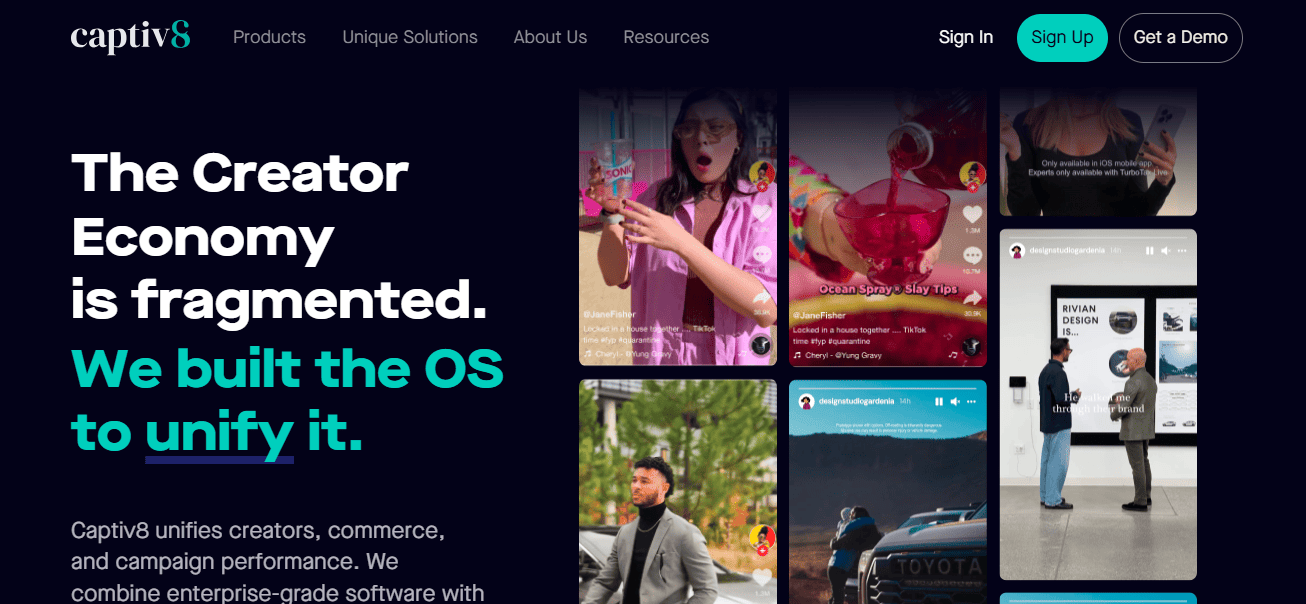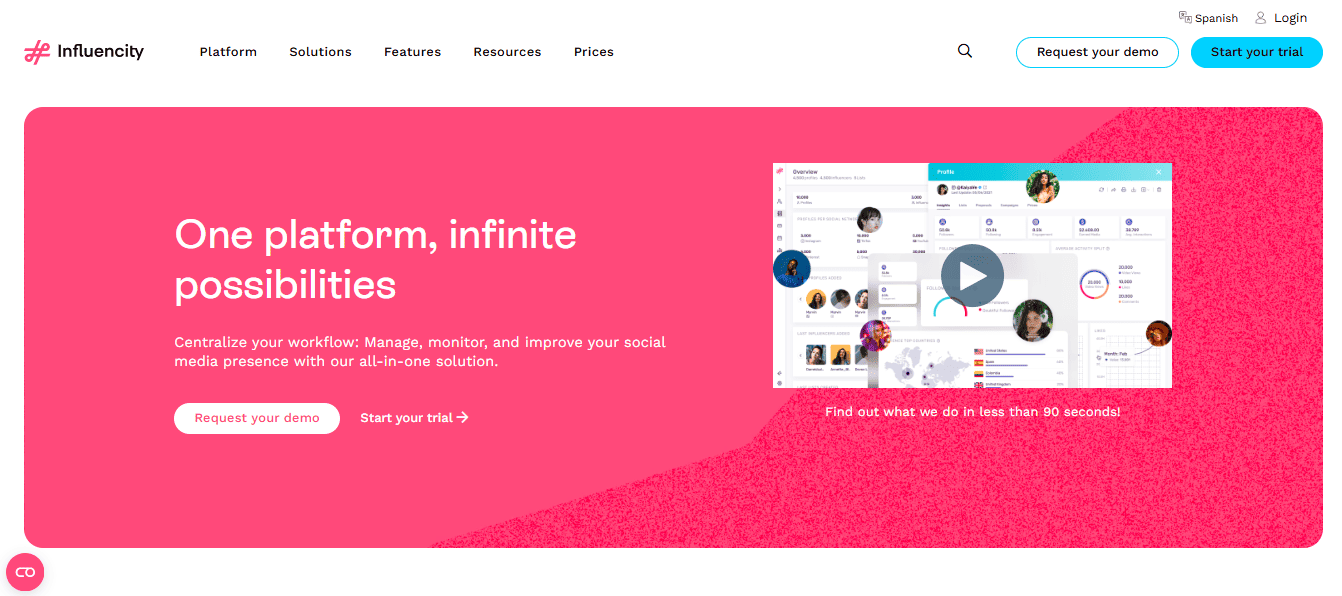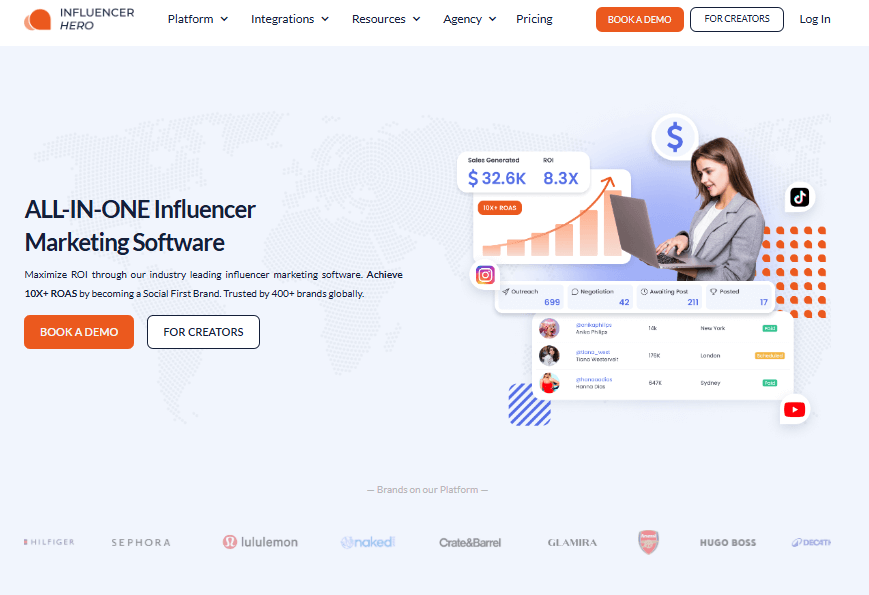


The main difference between Captiv8 vs Influencity vs Influencer Hero lies in their focus and accessibility for brands. Captiv8 is designed for large enterprises running multi-channel campaigns with heavy data needs, offering deep analytics, competitor tracking, and campaign collaboration — but it comes with a steep cost starting at $25,000 per year plus $20,000–$30,000 per month for affiliate and storefront features.
Influencity caters to mid-sized brands that want a structured, data-driven workflow across discovery, CRM, and reporting, starting at $3,816 per year. Influencer Hero, meanwhile, is tailored for D2C eCommerce brands that want to scale quickly with automation, multi-platform support, and built-in Shopify and WooCommerce integrations, starting at just $649 per month with flexible commitments.
In short, Captiv8 targets enterprise budgets, Influencity focuses on mid-market usability, and Influencer Hero provides an affordable, automation-driven alternative built for performance and scalability. In this article, we’ll dive deeper into how these three platforms compare in features, pricing, pros, and cons to help you choose the best fit for your brand.
Captiv8 is designed for enterprise-level organizations managing large influencer budgets and complex multi-team campaigns. Influencity focuses on mid-sized marketing teams that need an organized workflow for managing multiple campaigns. Influencer Hero, on the other hand, is built for D2C and eCommerce brands, offering scalability and automation without the enterprise price tag.
Captiv8 starts at $25,000/year with additional costs for onboarding and storefront features, making it a major investment suited for large corporations. Influencity starts at $3,816/year, offering a lower entry point but limited flexibility. Influencer Hero provides monthly plans starting at $649, allowing brands to scale as needed without long-term commitments.
Captiv8 offers integrations with Shopify and Refersion, which are useful but limited to enterprise users. Influencity connects primarily to Shopify, focusing on gifting and affiliate tracking. Influencer Hero stands out with Shopify, WooCommerce, and custom eCommerce integrations, making it ideal for D2C brands running their own online stores.
Captiv8 gives access to over 15 million creators, complete with advanced filters, competitor insights, and sentiment analysis. Influencity also includes 15M+ profiles, using AI to match creators through hashtags and keywords. Influencer Hero offers AI-assisted search with fake follower detection and engagement filters, helping brands find the most authentic and ROI-driven creators.
Captiv8 focuses on collaboration with internal teams, offering comment and approval features but limited automation. Influencity provides a visual CRM with tagging, lists, and manual follow-ups via email. Influencer Hero takes it further with an AI-powered CRM, automated email sequences, and predictive analytics to streamline outreach and maximize response rates.
Influencer Hero is the best choice for D2C and eCommerce brands that rely on Shopify or WooCommerce, offering seamless integrations that let you manage gifting, affiliate tracking, and storefronts all in one place. While Captiv8 caters to large enterprises with deep analytics and competitor tracking, its pricing and complexity make it difficult for smaller brands to justify. Influencity, on the other hand, serves mid-market teams with solid campaign organization but lacks automation and flexible billing.
Where Influencer Hero truly stands out is in its automation and scalability. It combines AI-powered CRM workflows, automated email sequences, and predictive analytics—helping your marketing team save time while driving measurable results. Unlike Captiv8’s rigid enterprise structure or Influencity’s manual-heavy setup, Influencer Hero lets growing brands launch and manage influencer campaigns efficiently without sacrificing performance or usability. For fast-moving eCommerce teams that want results, not red tape, Influencer Hero is the smarter, more agile choice.

Captiv8 is an enterprise-grade influencer marketing platform built for large brands and agencies managing multiple high-budget campaigns. Its main purpose is to provide deep influencer insights, campaign management, and comprehensive analytics to help marketing teams understand audience sentiment, measure ROI, and identify creators working with competitors. Captiv8 focuses on scale, collaboration, and performance tracking, making it a strong option for enterprise D2C teams and agencies that prioritize analytics and advanced reporting over affordability.
Captiv8 is best for enterprise-level brands and agencies that need advanced analytics, competitive tracking, and global influencer management at scale.
Captiv8 pricing starts at $25,000 per year (annual contract only) with a $3,000 onboarding fee. Access to affiliate and storefront features requires an additional investment of $20,000–$30,000 per month, typically offered as part of their managed services plan.
Captiv8 does not offer any free tools or freemium versions. Access to all features requires a paid annual subscription, making it an investment primarily suited for larger organizations.

Influencity is an all-in-one influencer marketing platform built to help brands manage the entire influencer campaign process — from discovery and outreach to tracking and reporting. Its main purpose is to simplify campaign management through automation, strong CRM capabilities, and detailed data insights, allowing marketing teams to evaluate influencer performance and streamline their workflow. With direct integration to Shopify, Influencity is particularly useful for D2C and mid-sized brands running affiliate or gifting campaigns.
Influencity is best for mid-sized D2C brands and agencies that want an organized influencer management system with Shopify-based affiliate tracking and structured reporting.
Influencity offers two main plans:
All plans are annual, with optional add-ons.
Influencity does not offer free tools or a freemium version. All features require a paid annual subscription. However, demo access may be available upon request for enterprise evaluations.

Influencer Hero is an all-in-one influencer marketing platform designed specifically for D2C and eCommerce brands that want to manage influencer outreach, gifting, affiliate tracking, and payments — all in one place. Based on demo insights and customer data, it stands out for combining CRM automation, influencer discovery, affiliate dashboards, and real-time analytics under one platform, eliminating the need for multiple tools. Unlike enterprise-only platforms such as Captiv8 or Influencity, Influencer Hero is accessible to both growing Shopify stores and established brands running high-volume influencer programs.
Influencer Hero is best for Shopify, WooCommerce, and Amazon-based D2C brands that want to automate influencer campaigns, manage affiliates, and scale their partnerships without enterprise-level pricing or complex onboarding.
Based on sales and demo data, Influencer Hero offers the following plans:
Contracts are monthly or annual, with savings available for annual commitments.
Influencer Hero offers a wide range of free influencer marketing tools. Among them, you will find:
When comparing Captiv8, Influencity, and Influencer Hero, the main differences come down to pricing, usability, and level of automation. Captiv8 stands out for its enterprise-level analytics, competitive tracking, and sentiment analysis, but its steep pricing and complexity make it less accessible for most D2C or mid-sized brands. Influencity offers a well-rounded system with CRM functionality and Shopify integration, but lacks automation in outreach and requires add-ons for full tracking capabilities—making it better suited for teams that don’t need high-volume influencer outreach or affiliate management.
In contrast, Influencer Hero provides the perfect balance of affordability, automation, and integration. It’s an all-in-one platform where brands can discover influencers, automate outreach, manage relationships, and track affiliate sales without needing external tools or costly add-ons. With seamless Shopify and WooCommerce integration, transparent creator dashboards, and built-in AI outreach tools, Influencer Hero empowers brands to scale campaigns efficiently while keeping operations simple and affordable.
Book a free demo with Influencer Hero today to see how you can streamline your influencer marketing and drive more sales — all from one platform.
Schedule a Demo with one of our media experts below.